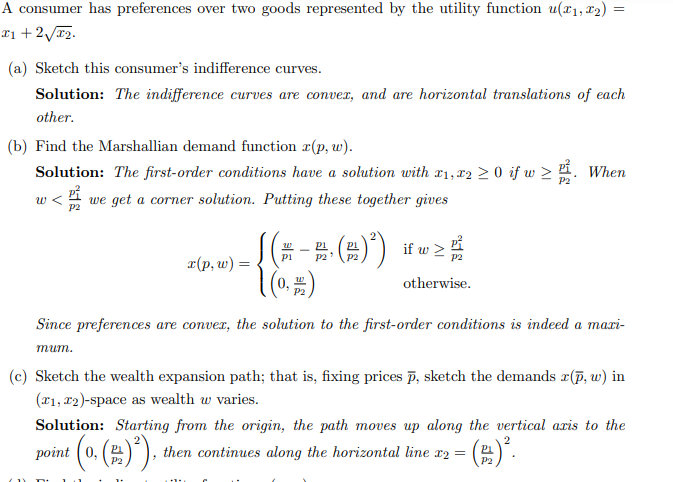A consumer has preferences over two goods represented by the utility function (1.12) x1 +2√x₂. (a) Sketch this consumer's indifference curves. Solution: The indifference curves are conver, and are horizontal translations of each other. (b) Find the Marshallian demand function x(p, w). Solution: The first-order conditions have a solution with x₁, x2 ≥ 0 if w≥ w< we get a corner solution. Putting these together gives P2 [(*- -· (-)²) 4¹ (²)²³) if w≥ 4 1 (0, #1) otherwise. r(p, w) = When Since preferences are conver, the solution to the first-order conditions is indeed a maxi- mum. (c) Sketch the wealth expansion path; that is, fixing prices p, sketch the demands r(p, w) in (11, 12)-space as wealth w varies. Solution: Starting from the origin, the path moves up along the vertical axis to the point (0,2 (0, (2)²), then continues along the horizontal line x₂ = PL P2
A consumer has preferences over two goods represented by the utility function (1.12) x1 +2√x₂. (a) Sketch this consumer's indifference curves. Solution: The indifference curves are conver, and are horizontal translations of each other. (b) Find the Marshallian demand function x(p, w). Solution: The first-order conditions have a solution with x₁, x2 ≥ 0 if w≥ w< we get a corner solution. Putting these together gives P2 [(*- -· (-)²) 4¹ (²)²³) if w≥ 4 1 (0, #1) otherwise. r(p, w) = When Since preferences are conver, the solution to the first-order conditions is indeed a maxi- mum. (c) Sketch the wealth expansion path; that is, fixing prices p, sketch the demands r(p, w) in (11, 12)-space as wealth w varies. Solution: Starting from the origin, the path moves up along the vertical axis to the point (0,2 (0, (2)²), then continues along the horizontal line x₂ = PL P2
Chapter6: Consumer Choice Theory
Section6.A: Indifference Curve Analysis
Problem 11SQ
Related questions
Question
please teach explain step by step

Transcribed Image Text:A consumer has preferences over two goods represented by the utility function u(x₁, x₂) =
x1 + 2√√x₂.
(a) Sketch this consumer's indifference curves.
Solution: The indifference curves are conver, and are horizontal translations of each
other.
(b) Find the Marshallian demand function x(p, w).
Solution: The first-order conditions have a solution with x₁, x2 ≥ 0 if w≥ B. When
w < we get a corner solution. Putting these together gives
P2
x(p, w) =
(= - = ( ² )²³) if w ≥
(0, 2)
P2
otherwise.
Since preferences are conver, the solution to the first-order conditions is indeed a maxi-
mum.
(c) Sketch the wealth expansion path; that is, fixing prices p, sketch the demands x(p, w) in
(21, 22)-space as wealth w varies.
Solution: Starting from the origin, the path moves up along the vertical axis to the
point
then continues along the horizontal line x2 = P2
2
+ (0₁ (2) ²), i
Expert Solution
This question has been solved!
Explore an expertly crafted, step-by-step solution for a thorough understanding of key concepts.
Step by step
Solved in 2 steps with 2 images

Knowledge Booster
Learn more about
Need a deep-dive on the concept behind this application? Look no further. Learn more about this topic, economics and related others by exploring similar questions and additional content below.Recommended textbooks for you





